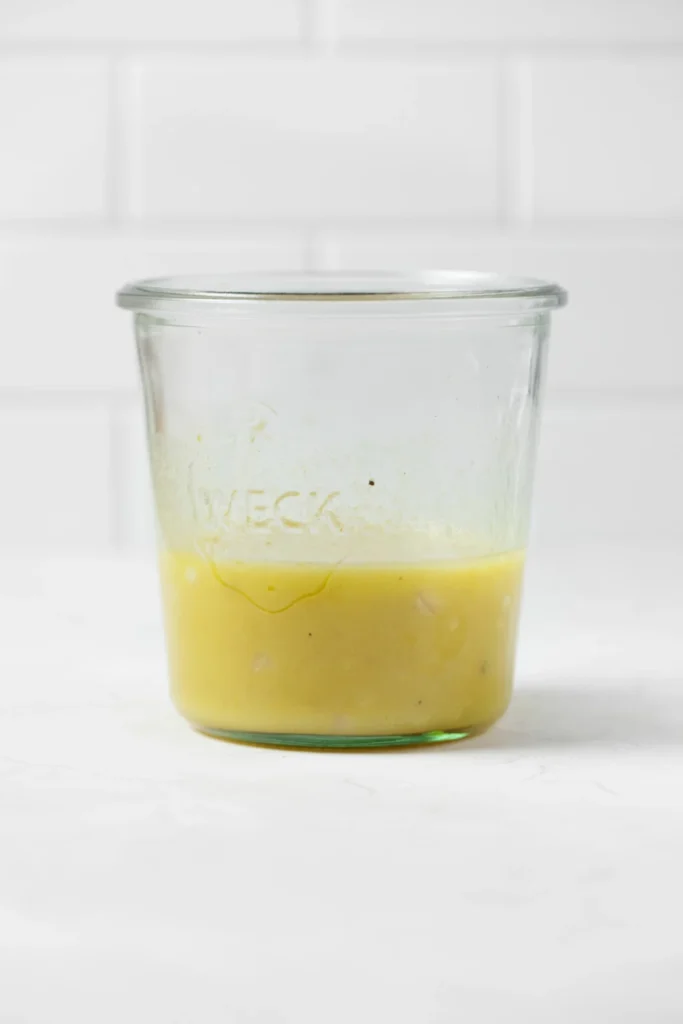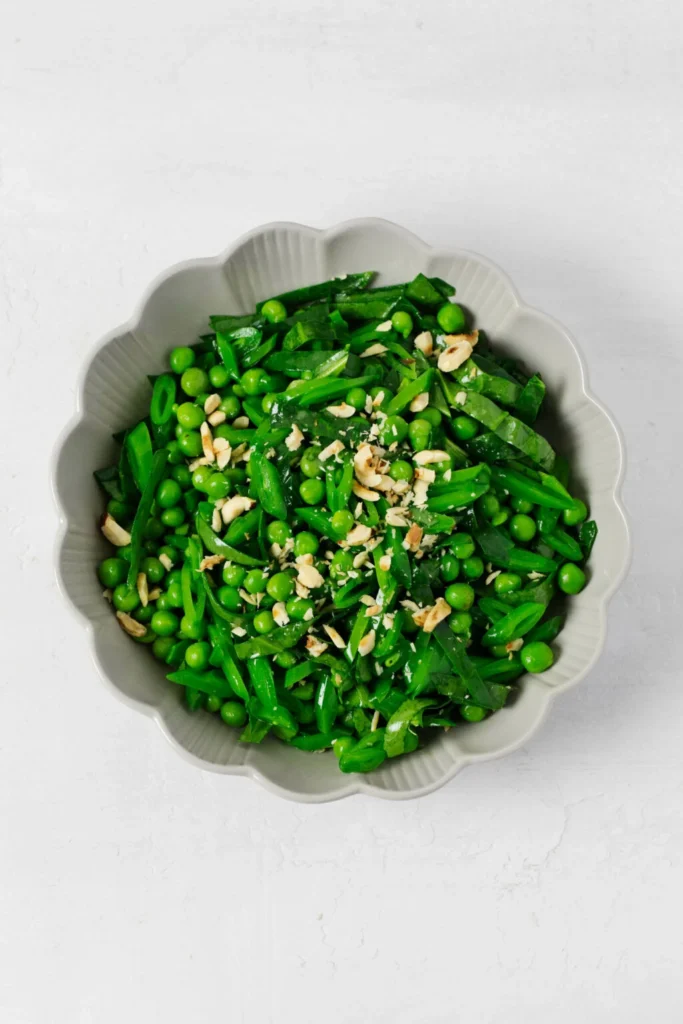When you think of peas, what recipe comes to mind?
Pea soup, macaroni and cheese and peas, rice and peas, or pasta primavera.
In other words, soup and cereal.
I never thought peas would be the star of a delicious little salad.
But now, they’re playing that role alongside a different kind of green pea: thinly sliced or snow peas.
The result is a crisp, sweet, super-fresh green pea salad with a beautiful color. I’m glad to be able to tell you.

The return of side dishes
This year, side dishes are back in vogue in my kitchen.
I don’t make side dishes at home, but I do prepare simple vegetable side dishes to accompany my vegetarian main course.
I share some of my favorites in my cookbook Vegetarian Week, such as braised green beans and tomatoes and braised kale with garlic.
However, no matter how routinely I prepare them, vegetable garnishes are not the main focus of my recipe development.
There are two reasons for this. First, the recipes I share on this blog reflect my focus as a home cook.
For a long time, especially when I was in graduate school, side dishes that required little work to make felt like a bad investment.
After all that time in the kitchen, do you eat only part of a meal? No, thank you.
I stick to the simplest side dishes: steamed broccoli, a simple green salad, and microwaved bags of green beans topped with vegan butter.
In the meantime, I’m working on the power board. My observation inspired the book, which states that a significant habit that prevents people from eating a balanced diet is not paying attention to the three macronutrients—protein, fat, and carbohydrates—in each meal.
I turned every recipe in the book into a complete meal that included a few foods from various macronutrient categories.
Since then, I have thought of a complete meal because I’ve spent much time talking to my clients about the value of three meals a day.
It’s a muscle memory that doesn’t go away. After looking at many recipes, my inner question was, “How do I turn this into a meal?” What should I serve with it?
This is how I gradually drifted away from both sides.
This year, however, they are making a comeback.
Step forward (to vegetables)
As is often the case, my recipe creation comes from my problem-solving process with clients.
At one point last fall, many of my clients told me they were finding it difficult to incorporate vegetables into their meals.
There could be several reasons for this. The weather is more relaxed, so side salads – the default vegetable side dish in many homes – are less appealing than in summer.
Collective fatigue may also be involved. I wrote Power Boards before COVID-19. We have all been through so much since then and continue to be through so much. People are tired, which is understandable.
Like many groceries, produce is getting more expensive.
Whatever the case may be, customers feel uninspired regarding vegetables.
While I still spend much time working with clients on macronutrient balance, I steer them toward vegetable-rich lunch and dinner choices.
“Generous” does not necessarily mean the half-plate portion suggested by My Plate. It’s a well-intentioned guideline, but it’s not for everyone.
I just invite clients to think about vegetables they already love and then to lean in.
Stir vegetables into soups and pasta dishes. Try to add color to your lunch bowl. Add vegetables to sauces or condiments.
Or, to make a meal more satisfying and complete, serve it with a plate of top-notch vegetable side dishes.
An inspiring spring salad
A few months ago, I ate at a restaurant that featured baby spinach and snow pea salad.
I would usually order something other than this. I tend to eat the leafy salad first, and at the time, I was at the height of my late-winter obsession with chicory.
But the salad was there, and it was the only appetizer on the menu. I wanted to give it a try.
I’m glad I did.
It was one of the best restaurant salads I’ve had all year. Chef Shaun Hergatt’s approach is straightforward. The salad has a scallion vinaigrette and is topped with crushed, roasted, and peeled hazelnuts.
But these are just the finishing touches, and I’ve omitted the ricotta cheese usually used in salads.
The star of this salad is sweet, crispy snow peas and thinly sliced baby spinach. It was far from the mayonnaise and creamy pea salad I’d seen before.
It’s a restaurant dish or food, much like the yummy sauce I shared on Monday, which I knew immediately I would make at home.
This was the birth of my fresh green pea salad and champagne vinaigrette.
Peas, please
Before I say anything else, I need to provide a few notes about the types of peas in a green pea salad.
There are two kinds. The first is the shelled pea, or English pea, which has been shelled.
You can use fresh or frozen peas, whichever is most accessible and appealing.
I prefer frozen peas to fresh peas: I find them sweeter, less starchy, and more tender. (Plus, I’m a fan of frozen vegetables.)
However, if you have shelled peas in your garden at home or want to celebrate their season at a farmer’s market, go for it!

The second type of pea you want to use is jelly beans or snow peas.
Although they are not the same vegetable, they can be used interchangeably in a pea salad. Both peas will work as long as you carefully cut them very thin.
Speaking of slicing, here are more details on how to make the salad.
How to make a super fresh green pea salad
First of all, what makes this salad so fresh?
This is probably because snow peas are both raw—you can use either of them, by the way. In their raw state, they taste sweet and green.
At the same time, the shelled peas are cooked. The first step in preparing salads is steaming, boiling, or microwaving them until they turn green, sweet, and tender.
Crunchy peas + sweet, tender green peas = bright, sweet, fresh effect. It’s spring in a bowl.
In this salad, it’s essential to slice the peas or snow peas and spinach very thinly. I know this step is time-consuming, but trust me! Texture is the key to this salad.

Balanced, bright spices
Another highlight of the pea salad is the sauce.

I shared my simple champagne vinaigrette, the most common vinaigrette I make at home in the fall. I’ve had some great feedback so far, and I’m glad other people find it as versatile as I am!
One thing I like about this vinaigrette is its overall balance.
It’s sour, as a vinaigrette should be, but not too tart. It has a hint of sweetness. Finely chopped shallots add flavor, but not enough to mask the lightness of the sauce.
Vinaigrette is perfect for a pea salad. It adds flavor to the vegetables by adding the necessary salt, acid, and fat.
You can prepare the vinaigrette a few days before you make the salad. If you like, then you can even double it.
Mix and finish
Once the dressing is done, pour it over fresh chopped green beans and spinach.
I used about six tablespoons, less than a whole batch of vinaigrette. (I’ve never found a use for those last few tablespoons at another point in time.)

First, coat the vegetables in six tablespoons of champagne vinaigrette. After mixing the salad, you can add extra seasonings.

The salad should have a nice layer of sauce but not be weighed down by the sauce. Adjust salt, pepper, and vinegar as needed.
Finally, you can add a crunchy texture to the green pea salad, such as roasted nuts.
I was inspired by Shaun Hergatt’s salad, which has hazelnuts. Although I don’t use hazelnuts very often, I love all kinds of hazelnuts, so I use them all the time when I make my own at home.

If you don’t have hazelnuts, that’s no problem. Chopped, toasted, salted almonds, shelled pistachios, pecans, or walnuts will work.
Suppose you want to emphasize the salad’s sweetness. In that case, you can use my vegan pecan candy or crispy toasted pecan candy instead.
Finally, you can choose to add fresh, chopped mint leaves to your salad. They’re a great addition to the fresh notes I’ve been talking about.
That said, I made salads without and without fresh herbs, and I liked both versions.
Meal preparation & storage
This salad is best served immediately after mixing.
However, you can slice the vegetables a day or two before mixing them to be ahead of the curve in the process. Store them in an airtight container in the refrigerator, along with damp paper towels.
The vinaigrette can also be prepared up to 5 days before mixing.
Finally, once you’ve wrapped the salad, you can store it in an airtight container in the refrigerator for a day or two. It will lose a bit of crunch, but it will still be delicious!



More spring side dishes
In the spirit of celebration, here are a few more dishes to complete and contribute to your meal.
I chose a few side dishes of varying sizes to express the flavors and ingredients of spring.
- Quinoa black rice salad with peas
- Creamy mushroom and spinach macaroni
- White lentils, butter lettuce, radish salad with creamy lemon cashew sauce
- Artichoke white bean bun
- Vegetarian barley risotto with asparagus and mushrooms
- Creamy brown rice with shiitake mushrooms and peas
- Pasta salad with curry Tahini sauce
- Green Goddess Spring Socca
- Strawberry jam salad
- Cashew butter pea soup
Here’s my latest favorite bowl of fresh green delicacy: pea salad.

Ingredients
12 ounces frozen green peas or fresh shelled English peas (340 grams, or 2 2/3 cups)
8 ounces raw sugar or snow peas (225 grams, or 2 cups)
1 ounce light package baby spinach leaves (30 grams, or 1.5 cups)
6 tablespoons simple champagne vinaigrette (more as needed)
2 tablespoons chopped fresh mint leaves (5g; Optional)
1/4 cup roasted, pickled, shelled, roughly chopped hazelnuts, pistachios, or almonds (30g; Optional)
Instructions
- Boil the bag according to the package directions, drain it, cover it with a tea towel, and let it cool for 15 minutes. Alternatively, boil a pot of water and add fresh peas. Cook for 3-5 minutes or until they are green, sweet, and tender. Drain the peas, cover with a tea towel, and let cool for 15 minutes.
- While the peas are cooling, cut the snow peas into thin slices along the diagonal – about 1/16 inch / 2 mm. Do the same with the spinach leaves. Skinny slices are the key to this salad’s specialty, so it’s worth your time!
- Place the cooled green beans, sliced snow peas, and spinach in a medium mixing bowl. Add the vinaigrette and mix well. Taste the salad and season with salt and pepper as needed. If you like, add chopped fresh mint leaves.
- Serve the salad with a tablespoon of chopped roasted nuts per serving, if you like. Enjoy.


